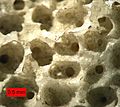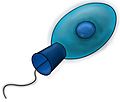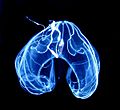Sponge facts for kids
Quick facts for kids Porifera |
|
|---|---|
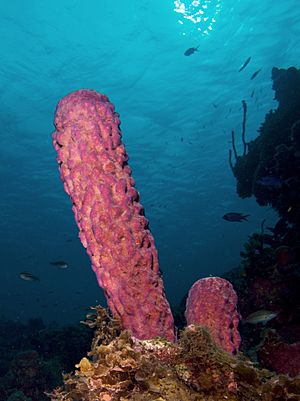 |
|
| A stove-pipe sponge | |
| Scientific classification |
|
| Kingdom: | Animalia |
| Phylum: | Porifera Grant, 1836 |
| Type species | |
| Amphimedon queenslandica |
|
| Classes | |
|
|
| Synonyms | |
A sponge is a member of the animal group called Porifera. It's a simple animal with many cells, but it doesn't have a mouth, muscles, heart, or brain. Sponges are sessile, meaning they stay in one place, like plants do. Even though they are simple, sponges are very successful creatures.
Their bodies have a jelly-like layer between two thin layers of cells. They are full of tiny pores and channels. These allow water to flow through them. Most sponges eat bacteria and other tiny living things called microorganisms. Some even eat small crustaceans.
There are over 10,000 different species of sponges. Most of them live in the ocean. A few kinds live in fresh water. All sponges pull water into their bodies through their pores. The water then leaves through a large opening in the center. Most sponges are filter feeders. This means they filter out small bits of food from the water as it passes through their bodies.
Sponges are some of the oldest animals we know about. We have found sponge fossils from about 635 million years ago!
Contents
What Makes Sponges Special?
Sponges are simple animals, but they have some unique features.
- A living sponge can change its body shape. Most of its cells can move around. Some cells can even change from one type to another.
- Sponges have a non-living, jelly-like middle layer. This layer is between two main cell layers. This is similar to cnidarians (like jellyfish) and ctenophores (comb jellies).
- Sponges do not have a nervous system. Their middle jelly layer has many different cell types. Cells from the outer layers can move into this middle layer. They can then change what they do.
- Sponges can protect themselves from animals that want to eat them. They release special chemicals. These chemicals can be toxic. They also stop other organisms from growing too close to them.
Different Kinds of Sponges
There are four main classes of sponges. They are different based on what their skeleton is made of.
- Demosponges make up most of the sponges. Their skeletons are made from a special protein called spongin. All the very large sponges belong to this group.
- Bony sponges use calcium carbonate to build their skeletons. They are also called Calcarea. These sponges are usually very small, only about 3-4 inches tall. About 400 of the 15,000 known sponges are Calcarea.
- Glass sponges use silicon dioxide for their skeletons. They are sometimes called Hexactinellida. Most glass sponges live deep in the ocean. There are about 500 different types of glass sponges. They make up about 7% of all known sponges.
- Homoscleromorpha used to be grouped with Demosponges. However, scientists now know they are a separate class.
How Sponges Live
Movement
Most sponges are sessile. This means they stay in one place, attached to the ground. A few sponges can move very slowly. They can creep along at about 1 to 4 millimeters a day. They move like amoebae. Some sponges can even shrink their whole bodies. Many can also close their openings or holes.
Carnivorous Sponges
Some sponges live in places where there isn't much food. Because of this, they have become predators. They eat small crustaceans and other tiny animals. Most of these meat-eating sponges belong to the family Cladorhizidae. Some from the Guitarridae and Esperiopsidae families are also carnivores.
We don't know much about how they catch their prey. Some sponges might use sticky threads or hooked spicules (tiny sharp bits). Most carnivorous sponges live in very deep waters, up to 8,840 meters (5.5 miles) deep. Scientists expect to find more of them as they explore the deep ocean. One type has even been found in Mediterranean caves, at depths of 17-23 meters. These cave-dwelling predators catch crustaceans less than 1 millimeter long. They trap them with fine threads, then digest them over a few days. They don't seem to use venom.
Most carnivorous sponges have lost their water flow system and choanocytes (special feeding cells). However, the Chondrocladia genus uses a changed water system. It inflates balloon-like parts to catch prey.
Reproduction in Sponges
Asexual Reproduction
Sponges can reproduce when small pieces break off. If a piece has the right cells, it can grow into a new sponge. Some sponges also use budding. This is when a small sponge grows on the parent sponge. When it's ready, it simply falls off. If conditions are bad, some sponges can form lumps of special cells. These lumps won't grow until conditions get better. They can then form a new sponge or use the skeleton of the parent sponge if it died.
Sexual Reproduction
Most sponges reproduce sexually. They can make sperm cells that are released into the water. These sperm cells are then caught by another sponge. They travel to the egg cells inside that sponge. This is called viviparous reproduction. The sperm and egg join to form larvae. These larvae can swim away to find a good place to settle and grow.
Another way, called oviparous reproduction, is when both sperm and egg cells are released into the water. They then combine outside the sponges.
Defenses
Many sponges shed tiny, sharp pieces called spicules. These spicules form a thick carpet on the seabed. This carpet can be several meters deep. It helps keep away animals like echinoderms (sea urchins, starfish) that might eat the sponges. Sponges also make toxins. These toxins stop other animals, like bryozoans or sea squirts, from growing on or near them. This helps sponges compete for living space.
A few species, like the Caribbean fire sponge Tedania ignis, can cause a bad rash if humans touch them.
Some turtles and fish mainly eat sponges. It's often said that sponges use chemicals to defend against these predators. Glass sponges don't make toxic chemicals. They live in very deep water where there are few predators.
Lifespan of Sponges
Sponges in cooler areas usually live for only a few years. But some sponges in tropical waters, and maybe some deep-ocean ones, can live for 200 years or even longer! Some hard demosponges grow very slowly, only about 0.2 millimeters (0.008 inches) per year. If they grow at this steady rate, a sponge 1 meter (3.3 feet) wide could be around 5,000 years old!
Sponges as Tools
Used by Dolphins
In 1997, scientists saw something amazing in Shark Bay. Bottlenose dolphins were using sponges as tools! A dolphin might put a marine sponge on its rostrum (its snout). Scientists think the sponge protects the dolphin's snout when it looks for food on the sandy sea bottom. This behavior, called sponging, has only been seen in this bay. It's almost always done by female dolphins. A study in 2005 found that mothers teach this behavior to their daughters. All the dolphins that use sponges are closely related. This suggests it's a fairly new trick. Dolphins also use sponges to rub their skin against rocks. This helps them get rid of old or dry skin.
Used by People
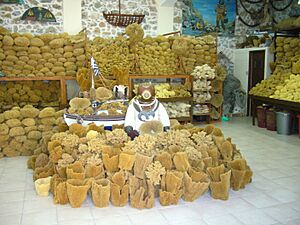
The calcium carbonate or silica spicules (sharp bits) in most sponges make them too rough to use. But two types, Hippospongia and Spongia, have soft, fibrous skeletons. Early Europeans used soft sponges for many things. These included padding for helmets, portable drinking cups, and water filters. Before fake sponges were invented, natural sponges were also used for cleaning and painting.
The few types of demosponges with soft, fibrous skeletons have been used by humans for thousands of years. They were used for padding and cleaning. By the 1950s, too many of these sponges were collected (overfished). The industry almost disappeared. Now, most sponge-like materials are made by humans.
Many things that look like sponges today are not from animals. These include cleaning tools for homes and for personal use.
The luffa "sponge," also spelled loofah, is often sold for kitchens or baths. But it's not from an animal! It comes from the fibrous "skeleton" of a gourd (Cucurbitaceae) plant.
Interesting Facts About Sponges
- Sponges are thought to be some of the oldest animals still alive today.
- Sponges are known for being able to grow back from broken pieces.
- Scientists are studying sponges and the tiny living things inside them. They hope to find new medicines to treat many diseases.
- All known living sponges can reshape their bodies. Most of their cells can move around. A few cell types can even change what they do.
- Sponges that have tiny living things inside them that do photosynthesis (like plants) can produce more oxygen than they use. They also create more organic matter than they consume. These contributions are very important for places like Australia's Great Barrier Reef.
Images for kids
-
Sponge biodiversity and different shapes at a wall site 60 feet (18 meters) deep.
-
Sponge choanocyte cells look like choanoflagellate protists. Their beating flagella pull water through the sponge for food and waste removal.
-
Euplectella aspergillum, a glass sponge known as "Venus' flower basket"
-
Euplectella aspergillum is a deep ocean glass sponge; seen here at a depth of 2,572 meters (8,438 feet) off the coast of California
-
Depth range of some sponge species Demosponge Samus anonymus (up to 50 m), hexactinellid Scleroplegma lanterna (~100–600 m), hexactinellid Aulocalyx irregularis (~550–915 m), lithistid demosponge Neoaulaxinia persicum (~500–1,700 m) -
Sponge loop hypothesis Steps of the sponge loop pathway: (1) corals and algae release dissolved organic matter (DOM), (2) sponges take up DOM, (3) sponges release detrital particulate organic matter (POM), (4) sponge detritus (POM) is taken up by sponge-associated and free-living detritivores. -
Raphidonema faringdonense, a fossil sponge from the Cretaceous period in England
-
Sponges made of sponge gourd for sale next to animal sponges (Spice Bazaar at Istanbul, Turkey).
-
Natural sponges in Tarpon Springs, Florida
See also
 In Spanish: Porifera para niños
In Spanish: Porifera para niños









